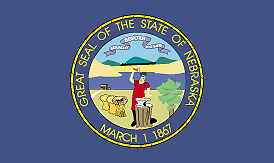| |
Nebraska
|
 |
NSF and Nebraska
In FY 2002 the NSF provided 95 awards totaling approximately $19 million to 9 institutions in the State of Nebraska as well as $96,000 in fellowships.
Institutions in Nebraska that received NSF support in FY 2002 include the University of Nebraska, Omaha Public Schools, the University of Nebraska Medical Center, and AIM Institute.
PROJECTS CURRENTLY FUNDED BY THE NSF IN THE STATE OF NEBRASKA
INCLUDE:
- Quantum and Spin Phenomena in Nanomagnetic Structures — The Materials Research Science and Engineering Center at the University of Nebraska supports an interdisciplinary research program on quantum and spin phenomena in nanomagnetic structures. The Center includes faculty participants representing the departments of physics, mechanical engineering, chemistry, and the school of biological sciences. The Center's research is organized into two interdisciplinary research groups: 1) Nanomagnetism: Fundamental Interactions and Applications, is concerned with the study of exchange and magnetostatic interactions between particles or grains in nanostructures; 2) Spin Polarization and Transmission at Nanocontacts and Interfaces, investigates spin polarization and transport through nanoscale magnetic contacts and at ferromagnetic/ferroelectric structures. Education outreach efforts include research experiences for teachers and for faculty-student teams from predominantly undergraduate institutions.
- Gas Chromatograph/Mass Spectrometer for Chemistry and Biology — Faculty at Doane College use a gas chromatograph/mass spectrometer to significantly increase the opportunities for students to acquire sophisticated data in its chemistry and microbiology courses. Students learn to critically evaluate the data from this instrument and to integrate that data with other data to solve progressively more difficult problems. The goal is to help students develop deductive reasoning and problem solving skills and gain hands-on experience with common modern instruments. Doane College is adapting a number of experiments from the Journal of Chemical Education and from the microbiology literature for inclusion in chemistry and biology curricula.
- Advanced Internet Satellite Extension Project — A combined effort by the American Distance Education Consortium and Tachyon, Inc. will develop and deploy advanced Internet services and technologies over satellite infrastructure to enhance research, instruction, and learning in a diverse set of institutions of higher education. The project focuses on bringing advanced networking applications to geographically remote campuses. By accessing previously unreachable campuses, the project will enable a broader community of scholars to engage in research, gain access to greater learning resources, and reach a more diverse student population.
- Galois Structures in Local Number Fields — An NSF Research in Undergraduate Institutions award to the University of Nebraska – Omaha supports research in algebraic number theory, specifically what are the invariants that determine the Galois module structure of ideals? and what is the effect of twists by characters of Galois representations on these structures? In addition this award will support undergraduate students who are engaged in number theoretic research.
For more information on Nebraska and NSF, please contact the Office of Legislative and Public Affairs at 703-292-8070.
Useful Links:
Nebraska
Governor's Office
Nebraska
State Government
|
|


